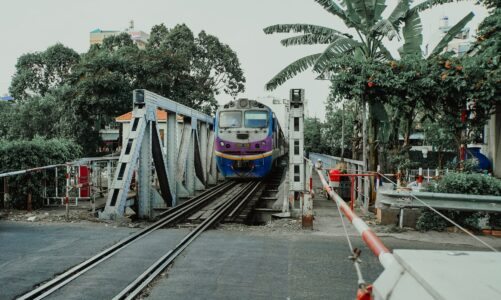Batteries have been used on rolling stock for many decades, but until recently they served mainly to power auxiliary consumers or as a backup power source designed to keep trains moving over short distances in the event of power outages. Now traction batteries are becoming a viable alternative to electrification and diesel fuel.
Experiments with battery-powered rolling stock have been conducted in various countries, notably Belgium, France, Germany, and Italy, since about 1890. In the United States, Edison-Beach motor cars equipped with nickel-iron batteries have been in operation since 1911. In New Zealand on the 34 km long Little River line from 1926 to 1934 a self-propelled car was operated on accumulator batteries with the range of 160 km (fig.1). In Ireland, Drumm nickel-zinc batteries were used on four two-car trains of the Harcourt Street line in Dublin from 1932 to 1946.
Although traction batteries have been attempted on rolling stock for more than 100 years, they have only relatively recently reached a level of development that allows them to begin to be implemented. In most cases, traditional electrification, which requires the construction of traction substations and overhead wiring, is still used to provide trains with power. However, this solution is appropriate only for lines with sufficiently high traffic intensity.
Batteries are often referred to as an important alternative energy source for traction along with hydrogen fuel cells, but it should be remembered that fuel cell trains must also be equipped with traction batteries. Fuel cells provide the average level of energy required for traction, but do not provide the short-term peak energy needed to accelerate the train. Therefore, fuel cells serve to continuously charge the intermediate battery that generates the energy used for traction. Batteries also allow the energy released during regenerative braking to be stored, further enhancing their use on rolling stock.
The benefits of traction batteries are largely related to, but not limited to, environmental performance. Optimized batteries can be used to power auxiliary devices (heating, ventilation, air conditioning), which are often the second largest consumer of energy on rolling stock after the traction drive. In addition, they can be used for power supply of the train during washing and cleaning or for its movement around the depot, thus eliminating the need to lift the current collector or start the diesel engine.
According to estimates, the number of diesel trains currently operating in Europe, which in the next 10-15 years will have to be replaced, varies from 2 to 10 thousand. Instead, they will be replaced by electric trains powered by the contact network, hybrid trains or rolling stock powered by alternative energy sources.
Rolling stock suppliers believe that the market for trains equipped with traction batteries has not yet formed. At the same time, according to experts, there is a need for trains that do not use diesel engines, and the question of choosing the best traction technology for such trains remains open. At the same time, there are now almost no tenders for suburban and regional trains equipped exclusively with diesel propulsion systems.
For the first time traction batteries were used on urban rail transport, where the weight of the rolling stock is relatively low and energy consumption is significantly lower compared with mainline freight or passenger trains. Initially, it was supposed to recharge the onboard batteries at each stop, which allowed to refuse the use of the contact network, at least in some sections (Fig. 3). With advances in technology, it became possible to run the entire line without recharging, which is especially important in historic centers because contact wires are thought to distort the cityscape.
Currently, the level of technology development makes it possible to install traction batteries on shunting locomotives and regional passenger trains, as well as on freight locomotives. However, in this sector, the transition to battery traction is slower, both for technical reasons (due to the need to ensure higher traction and power indicators) and economic reasons.
Despite the reduction in the cost of batteries, the problem of battery life remains acute. During the life cycle of the rolling stock, the battery has to be replaced 2 or 3 times. The service life of a diesel engine is significantly longer.
Research
Europe is considered a leader in the development of battery-powered rolling stock, with manufacturers using mostly batteries supplied from Asian countries. Research is also being conducted in other countries of the world. Currently, lithium-ion batteries are mainly used in rail transport as traction batteries with lithium-containing substances in the cathode material. These include, in particular, lithium titanate oxide (LTO), lithium iron phosphate (LFP) and lithium nickel manganese oxide (LMNO) batteries. Batteries containing nickel, manganese, and cobalt (NMC) as cathode material are also common.
The use of batteries on rolling stock requires meeting fairly stringent requirements for fire protection, accident resistance and vandalism resistance. At the same time, the installation of traction batteries must not compromise the safety of the train. This explains why certain types of batteries should not be used in rail transport. The potential danger of batteries catching fire can be eliminated by a control system that prevents overheating; it also eliminates the possibility of over- or under-charging that could cause cell damage.
NMC batteries are typically used when high capacity is required, and LTO batteries when significant power is needed. Technology is evolving and improving, but so far even the latest developments do not provide a single solution that provides both sufficient capacity and high power density. The situation is expected to change with the appearance of solid-state lithium-ion batteries on the market, which could happen within the next 2 years. This will double the capacity, charge rate and power of the batteries.
The Blues train created by Hitachi Rail and demonstrated at InnoTrans 2022 was the first hybrid train to enter regular service in Europe, capable of running on overhead wires, diesel and batteries. In December 2022, the train, built for the Italian national operator Trenitalia, began carrying passengers to the island of Sicily (Fig. 6). It is expected that in the future such trains will appear in other regions of the country. The LTO batteries were chosen for the Blues train in accordance with the operator’s requirements. When powered by batteries, the train can accelerate up to 140 km/h and has a range of 60 km without recharging.
At the same time, preparations are being completed to put the Stadler-built FLIRT hybrid trains ordered by the British operator Transport for Wales into regular operation. A sample train was also displayed at InnoTrans 2022.
New technical solutions
Batteries are being improved incrementally, with a focus on increasing the power-to-weight ratio. To meet this challenge, alternative materials, particularly sodium, are being explored to replace lithium, the price of which has increased by more than 500% in the last 18 months due to logistics issues and the significant demand for electric vehicles.
This, combined with the relatively short life span of the battery compared to the train it provides energy for, contributes to the life cycle cost of battery-powered rolling stock. Most LTO batteries are designed for 20,000 charge-discharge cycles, which typically means replacing them every 8 to 10 years, and only a few last up to 12 years. This is significantly less than the minimum service life of 30 years established for new rolling stock. However, trains can be equipped with new batteries with improved characteristics when batteries are scheduled for replacement, since it is quite likely that technology will continue to evolve from the time the train is put into service.
For batteries used on rolling stock, one of the requirements is a shorter charging process. This increases the load on the battery, which leads to faster battery aging. Another important factor that affects battery life is the temperature at which the battery is stored and operated. Its influence is currently being studied.
Despite the similarity of basic technical solutions, due to the large number of charge-discharge cycles and significant loads typical of batteries installed on railway rolling stock, batteries used on electric vehicles are not suitable for use on electric trains and locomotives, even if a significant number of them are combined into a battery to obtain the power required to provide traction. Nevertheless, specialists are constantly monitoring the experience of battery use in other modes of transport, including road and water, as well as solutions concerning batteries used in industrial equipment. Experience shows that batteries for electric vehicles are designed specifically for this area of application, as they are tailored to the respective specifics of operation. On the railroad, conditions are quite different.
Rolling stock suppliers leave battery chemistry research to specialists in the field and focus primarily on developing control systems that charge and discharge batteries in such a way as to optimize performance and extend battery life. While the cell manufacturer can provide a two-year warranty, battery manufacturers or rolling stock manufacturers typically provide a battery module with a life of at least 8 years.
ABB has developed a remote battery condition monitoring system that provides a complete view of battery performance when operating within a given range. The system also identifies weak cells within the battery and offers an online portal where users can check the condition of their batteries.
An onboard lithium-ion battery reaches the end of its life when it loses 20 to 30 percent of its capacity. Research is currently underway to reuse partially depleted batteries before they are recycled. One potential solution is to install such batteries in stationary applications such as rapid charging points for light rail rolling stock, they can also be used to store energy derived from solar panels in power plants and other facilities.
Rationale for the choice
Rail transport is the most environmentally friendly way to transport both passengers and freight, but this advantage can only be fully realized by attracting more customers from other modes of transport. It is not reasonable to switch to battery power for rolling stock if such a solution is economically unjustified. Despite the attractiveness of new technologies, it is necessary to verify the effectiveness of their use in rail transport.
In some cases, decisions are made to introduce hydrogen fuel cell rolling stock on certain sections, although it seems more feasible to use battery-powered trains there. In other cases, where conventional electrification would be more appropriate, battery-powered rolling stock is being introduced. Operators should make more deliberate decisions about the appropriateness of different technologies on a case-by-case basis.
Growth in the supply of battery-powered rolling stock
Recently, not only in Europe, but worldwide, there has been an increase in orders for battery-powered trains.
Not all rolling stock manufacturers seek to implement the most advanced technologies, some continue to use proven solutions. For example, Schalke, which supplies battery-powered rolling stock for subways and the mining industry, is ready to offer products with lithium-ion batteries, but for now, its customers still prefer to use lead-acid batteries, as that technology is quite mature. Mining companies tend to be conservative and are not willing to take risks. The cost of lithium batteries is higher, and their operation requires solving problems related to fire safety.



